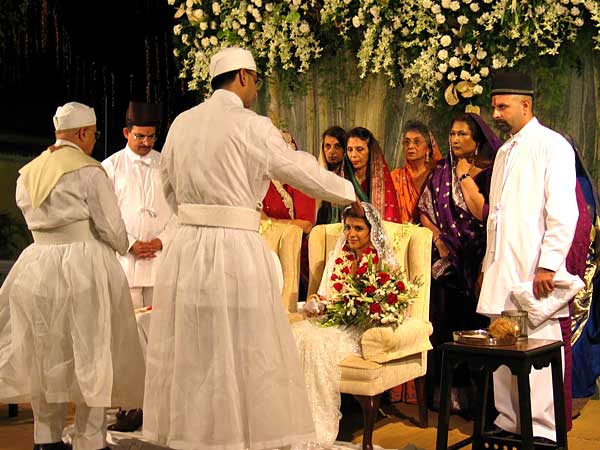Read this article to explore more about the traditional Zoroastrian or Parsi Wedding Ceremony.
Parsi Wedding Ceremony

|
Like other Indian marriages, thewedding rituals and customs of Parsi community are also spread over a couple of days. In Parsi wedding also, the wedding celebrations are divided into three parts- pre wedding rituals, wedding day rituals and post wedding rituals. As marriage is a religious ritual encouraged in the Parsi religion, Parsi people consider marriage to be an occasion of social as well as religious celebrations. If you are keen about knowing the details of the Parsi wedding ceremony, given below is the detailed description of the Parsi marriage traditions from Pre-Marriage to Post Marriage Traditions.
Pre Wedding Rituals
Among the pre wedding rituals or customs we have Madhavsaro, which is celebrated four days before the lagan(marriage day), the families of the bride and groom each plant a young tree in a pot, amidst recitation of prayers by the family priest, and place this at the entrance of their homes. Generally a mango plant is used for this ceremony as it is treated as a symbol of fertility. The plant is watered every morning till the eighth day after the wedding and then transplanted elsewhere.
‘Adarni' is the third day before the lagan and it is celebrated as a day for exchange of gifts. On this day the groom's family visits the bride's home and presents her with all kinds of gifts like clothes, jewelry, etc. The relatives, neighbors and friends are invited for a traditional meal of sev and dahi, boiled eggs and bananas. The immediate day before the wedding is called ‘Supra nu Murat' it is more like the mehendi and haldi ceremony of the Hindus. In this ritual four married women are given a supra each, containing paan, supari, haldi, dates and a piece of coconut. While singing traditional songs, these supras are exchanged seven times among the women cross-wise, length-wise and breadth-wise. A fifth lady sits in the middle with a khalbatto and dry turmeric. Then a paste of it is applied by all to the groom and bride along with a showering of blessings.
Wedding Day Rituals
‘Nahan' is the day of the lagan. On the occasion of Nahan, the staircase, doorway and gate is decorated with beautiful decorative designs of rangoli(colorful motifs). According to the Zorastrians the time immediately after sunset or very early in the morning is considered auspicious for marriage. For the marriage ceremony the bride dresses in her ‘Madhavate', the white, ornate wedding saree given by her parents, while the groom wears the traditional ‘Parsi Dagli and Feta', a white kurta like garment and a black cap. The Parsi lagan is called ‘Achumichu', which takes place either at a Baug or at an Agiary (the fire temple). A stage is build up for the couple and before they step on it, the groom first, a ritual called Achumichu is performed. The bride's mother takes a tray with a raw egg, supari, rice, coconut, dates and water and begins the ceremony with her son-in-law to be. In Ara antar ceremony the couple is made to sit facing each other with a cloth held between them, so they cannot see the other. Among the other main day rituals are Chero bandhvanu and Haath borvanu.
Post Wedding Rituals
In the post-wedding rituals the reception is held in a grand manner with varied menu of food, drink and music. The party is a whole night affair where all the guests have a lovely time. The menu mainly comprises of traditional Parsi dishes like Parsi bhonu like sarya (crisps), achaar - rotli (pickle and rotis), patra ni macchi (steamed fish), salli margi (chicken with potato crisps), lagan nu custard, pulao-dal and ice cream. The wedding ceremony ends with the couple being accompanied home by the bride's family and the Achumichu being performed once again by the groom's mother for the well being of the couple.



